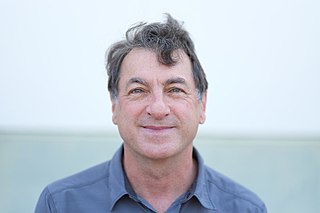
Ofer Biham is a faculty member at The Racah Institute of Physics of the Hebrew University of Jerusalem in Israel. Biham received his Ph.D. for research on quasiperiodic systems at the Weizmann Institute of Science in 1988, under the supervision of David Mukamel.

Rule 184 is a one-dimensional binary cellular automaton rule, notable for solving the majority problem as well as for its ability to simultaneously describe several, seemingly quite different, particle systems:
Daniel Amihud Lidar is the holder of the Viterbi Professorship of Engineering at the University of Southern California, where he is a Professor of Electrical Engineering, Chemistry, Physics & Astronomy. He is the Director and co-founder of the USC Center for Quantum Information Science & Technology (CQIST) as well as Scientific Director of the USC-Lockheed Martin Quantum Computing Center, notable for his research on control of quantum systems and quantum information processing.
The Biham–Middleton–Levine traffic model is a self-organizing cellular automaton traffic flow model. It consists of a number of cars represented by points on a lattice with a random starting position, where each car may be one of two types: those that only move downwards, and those that only move towards the right. The two types of cars take turns to move. During each turn, all the cars for the corresponding type advance by one step if they are not blocked by another car. It may be considered the two-dimensional analogue of the simpler Rule 184 model. It is possibly the simplest system exhibiting phase transitions and self-organization.

Frederick Duncan Michael Haldane, known as F. Duncan Haldane, is a British-born physicist who is currently the Sherman Fairchild University Professor of Physics at Princeton University. He is a co-recipient of the 2016 Nobel Prize in Physics, along with David J. Thouless and J. Michael Kosterlitz.

Kameshwar C. Wali was an Indian-born American theoretical physicist who was the Distinguished Research Professor of Physics Emeritus at Syracuse University's College of Arts and Sciences. He was a specialist in high energy physics, particularly symmetries and dynamics of elementary particles, and the author of Chandra: A Biography of S. Chandrasekhar and Cremona Violins: a physicist's quest for the secrets of Stradivari.
Réka Albert is a Romanian-Hungarian scientist. She is a distinguished professor of physics and adjunct professor of biology at Pennsylvania State University and is noted for the Barabási–Albert model and research into scale-free networks and Boolean modeling of biological systems.

Sriram Rajagopal Ramaswamy FRS is a professor at the Indian Institute of Science, Bangalore and was on leave (2012–16) as Director of the Tata Institute of Fundamental Research (TIFR) Centre for Interdisciplinary Sciences in Hyderabad.

Crispin William Gardiner is a New Zealand physicist, who has worked in the fields of Quantum Optics, Ultracold Atoms and Stochastic Processes. He has written about 120 journal articles and several books in the fields of quantum optics, stochastic processes and ultracold atoms

Maria Cristina Marchetti is an Italian-born, American theoretical physicist specializing in statistical physics and condensed matter physics. In 2019, she received the Leo P. Kadanoff Prize of the American Physical Society. She held the William R. Kenan, Jr. Distinguished Professorship of Physics at Syracuse University, where she was the director of the Soft and Living Matter program, and chaired the department 2007-2010. She is currently Professor of Physics at the University of California, Santa Barbara.

Antonio Helio de Castro Neto is a Brazilian-born physicist. He is the founder and director of the Centre for Advanced 2D Materials at the National University of Singapore. He is a condensed matter theorist known for his work in the theory of metals, magnets, superconductors, graphene and two-dimensional materials. He is a distinguished professor in the Departments of Materials Science Engineering, and physics and professor at the Department of Electrical and Computer Engineering. He was elected as a fellow of the American Physical Society in 2003. In 2011 he was elected as a fellow of the American Association for the Advancement of Science.

Amnon Aharony is an Israeli Professor (Emeritus) of Physics in the School of Physics and Astronomy at Tel Aviv University, Israel and in the Physics Department of Ben Gurion University of the Negev, Israel. After years of research on statistical physics, his current research focuses on condensed matter theory, especially in mesoscopic physics and spintronics. He is a member of the Israel Academy of Sciences and Humanities, a Foreign Honorary Member of the American Academy of Arts and Sciences and of several other academies. He also received several prizes, including the Rothschild Prize in Physical Sciences, and the Gunnar Randers Research Prize, awarded every other year by the King of Norway.

Mark John Bowick is a theoretical physicist in condensed matter theory and high energy physics. He is the deputy director of the Kavli Institute for Theoretical Physics at the University of California, Santa Barbara, and a Visiting Distinguished Professor of Physics in UCSB's Physics Department.
Yvan J. Bruynseraede is a condensed matter experimental physicist, known for his work on multilayers and superlattices, and his interests are thin films, nanostructures, novel materials, magnetism, and superconductivity. He is currently Professor Emeritus at the Catholic University of Leuven (KULeuven), and a member of the Quantum Solid-State Physics Laboratory.
David Alan Huse is an American theoretical physicist, specializing in statistical physics and condensed matter physics.
Tin-Lun "Jason" Ho is a Chinese-American theoretical physicist, specializing in condensed matter theory, quantum gases, and Bose-Einstein condensates. He is known for the Mermin-Ho relation.
Christopher John Pethick is a British theoretical physicist, specializing in many-body theory, ultra-cold atomic gases, and the physics of neutron stars and stellar collapse.
Alan Harold Luther is an American physicist, specializing in condensed matter physics.
Dietrich Belitz is an American theoretical physicist on the faculty of the University of Oregon. He studies statistical mechanics and condensed matter physics.
Dov I. Levine is an American-Israeli physicist, known for his research on quasicrystals, soft condensed matter physics, and statistical mechanics out of equilibrium.










